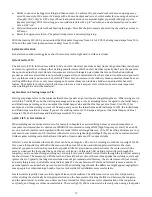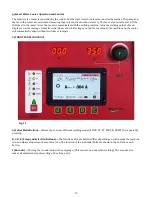
17
Ability to use one size bigger welding rod than normal—
To achieve this, you would reduce the max amperage even
more. For example, 110 amps or 120 amps with a 55 amp background current, which makes for an average heat input
of roughly (110 + 55)/2 = 82.5 amps. (The actual heat input may be somewhat higher, especially with higher pulse
frequency settings). With this setting, you can weld materials with a 1/8” rod when you would normally need to weld
with a 3/32” rod.
Weld on thinner material without burning through—
More like the first example about setting the welding current to
130 amps.
Easier for beginner welders—
The pulsed stick process is extremely forgiving.
With the Invertig 313/400, you can adjust the Stick pulse frequency from 0.4 to 5 PPS, the background amps from 10 to
90%, and the peak time (pulse-on time or duty) from 10 to 90%.
k) Hot-Start for Stick
Hot-start when stick welding gives a short burst of current to light hard to strike electrodes.
l) Hot-Start for TIG
The hot-start for TIG function is available in AC and in DC. Hot-start provides a short (in the range of milliseconds) burst
of current to ignite the arc. Many other welding manufacturers offer hot-start, but they typically don’t give the operator
the option to adjust hot-start. Hot-start ensures arc starts with tungsten electrodes that are not fresh and pristinely
ground, as well as material that is not perfectly prepared. If your material and torch are in mint condition, and you weld
on very thin material, you can turn hot-start off. This is very uncommon in the industry because most machines have arc
starting difficulties at low or very low amperages. Some machines even include a hidden, non-adjustable hot-start
feature. The ability to turn hot-start off allows you to have a true 4 amp arc start, which can be extremely important
when welding thin and critical material.
m) Hot-Start vs. Starting Amps in TIG
Starting amperage refers to the minimum that the foot pedal can go to without extinguishing the arc. When using a torch
switch in 4T or RESET mode, the starting amperage can also play a role as a limiting factor in regard to the Initial Amps
and Final Amps percentages. You can adjust the Initial Amps value and the Final Amps value from 10 to 90%. If, for
example, you set the welding current to 100 amps, and you set the Initial Amps and Final Amps to 10%, the Initial Amps
and Final Amps would be 10 amps; if you set the welding current to 150 amps, and you set the Initial Amps and Final
Amps to 10%, the Initial Amps and Final Amps would be 15 amps.
n) HF-, LIFT-, & Scratch-Start
When welding near sensitive electronics, for example in hospitals or assisted living homes or around computers or
computer control modules in vehicles, we STRONGLY recommend turning off HF (high frequency arc start). Even an AC
arc on a modern inverter can be ignited in lift-arc mode! HF travels long distances; 10 to 20’ traveling distances are very
common. In some instances, HF interferes with electronics in neighboring buildings if they are on the same transformer!
Unlike regular welding currents that travel the path of least resistance, HF is unpredictable.
Lift start, not to be mistaken for scratch-start, can be used to ignite a DC or an AC welding arc with the Invertig 313/400.
If you use a foot pedal, turn HF off in the menu, and then touch the clean and cold tungsten electrode to the clean
material you plan to weld on. Depress the foot pedal a little bit, at minimum, which activates the contact switch (the
more you depress the foot pedal, the easier the arc will ignite). At this point, NO welding current flows through the
tungsten, you are not shortening anything out, and only a very small control current flows through the torch, just sensing
the short circuit. The moment you lift the torch and break the short circuit, the machine applies the welding current and
ignites the arc. Typically, the tungsten electrode does not get contaminated this way, the arc starts smooth (not violent),
and everything is very controllable using the foot pedal. To choose between HF start and Lift start is more a matter of
personal preference and what a person is used to. When welding longer beads, the difference might appear negligible to
some people, but when making a bunch of spot or tack welds, HF is definitely more comfortable.
Scratch-start is typically done on older engine drives or stick welders. The difference is the arc is lit at full power by
either striking the electrically hot tungsten electrode on the base metal or flicking the filler rod between the tungsten
and the parent metal. In either case, unless you have trained for this procedure well, contamination of the tungsten is
very likely, and things are rather uncomfortable. The Invertig 313/400 can do scratch-start only when using a foot pedal
Содержание Invertig 313
Страница 6: ...6 Fig 1 ...
Страница 33: ...33 12 WIRING DIAGRAM Invertig 400 AC DC ONLY ...
Страница 34: ...34 13 EXPLODED VIEW INVERTIG 400 AC DC ONLY ...
















































